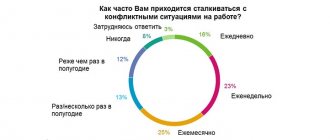Beginning of the conflict
Analyzing the essence of the conflict, we come to establish its time boundaries, namely, the moment of beginning and end. Determining these points is important for distinguishing a conflict from a pre-conflict, as well as developing strategies for resolving one or another type of conflict.
The beginning of a conflict is the initial act of opposition between the parties.
In order for a conflict to occur, three conditions must coincide:
- conscious and active actions to the detriment of another participant or group of participants, and here both physical actions and actions in the form of information transfer can be carried out;
- awareness of the direction of these actions against an opponent or group of opponents;
- In response to the actions taken, the opponent takes a response action against the first participant.
Are you an expert in this subject area? We invite you to become the author of the Directory Working Conditions
As a rule, when one of the interacting parties takes aggressive actions, the other takes a passive position. There may be no conflict in cases where one of the parties is planning a conflictual counteraction, but at the same time performs only mental actions, and not physical ones. Conflict can end in any form, with different outcomes. However, in any case, its completion implies the cessation of the opponents’ actions towards each other.
Dynamics of conflict
Conflicts develop in certain stages.
The latent period includes:
- the emergence of a problematic situation,
- awareness of its problematic nature by individuals,
- an attempt to resolve it in non-conflict ways,
- the emergence of a pre-conflict situation.
The emergence of a problem situation always precedes the development of a conflict. The essence of this situation lies in the emergence of a contradiction between subjects, namely between their aspirations, motives, goals and actions. If the situation is still non-conflict, but there are contradictions, such a situation is called problematic. It occurs under the influence of objective reasons. We encounter problematic situations every day - at work, in business, in the family, in everyday life, as well as in other areas and areas of life. Some problematic situations exist for a long period without manifesting themselves in any way.
Finished works on a similar topic
Course work Periods and stages of conflict 430 ₽ Essay Periods and stages of conflict 250 ₽ Test work Periods and stages of conflict 200 ₽
Receive completed work or specialist advice on your educational project Find out the cost
The situation creates a threat of conflict. But for this it is necessary that the situation turns into reality in combination with subjective factors. Conflict can arise only when an objective problem situation is realized.
In order for a situation to become a conflict, an individual must recognize it as a conflict. As a rule, this situation occurs when subjects have contradictions in the sphere of interests, morality, values, social attitudes, and so on. Each person is individual, and his awareness of the problem is also individual. The more complex the situation and the faster it develops, the greater the likelihood of it being distorted by subjects entering into conflict.
After the occurrence of a pre-conflict situation, conflict interaction or conflict itself occurs. The conflict includes the following stages:
- An incident is the first clash between the parties, an attempt to resolve the conflict in their favor. If one of the parties has enough resources, it can win, in which case the conflict will be limited to an incident. However, it is possible that the conflict will develop further as a series of conflict events and incidents. In this case, conflict actions begin to become more complicated, and therefore the structure of the conflict becomes more complex. This process can be represented as a verbal struggle, a manifestation of emotions, a perceptual error, the intensity of the struggle, and so on.
- Escalation is a sharp dynamic in the struggle between opponents.
- Balanced counteraction is a type of counteraction in which subjects interact, HOWEVER, the level of struggle is reduced. As a rule, force is not used at this stage, but an agreement has not yet been reached.
- Conflict resolution is the transition from conflict actions to finding a solution to the problem and ending the conflict for any reason. At this stage of the conflict, it is also possible for it to escalate into another conflict.
Latent stage
The conflict as such is preceded (more precisely, may be preceded) by a latent - hidden - stage, in which all the elements of the conflict exist, with the exception of external actions. Formally speaking, this stage can include five sequential events or stages in the development of the conflict.
The first event is the emergence of an objective conflict situation, which has already been discussed in detail above. In principle, a conflict situation can appear simultaneously with the identification of a conflict (in its open stage) or, as mentioned above, be deliberately provoked by one or both participants. But logically, a conflict situation is the first link.
The second event is awareness by at least one of the subjects of their interests in this situation. It is clear that interests can be misunderstood, distorted, or real and objective, but without their awareness, further struggle would have no basis.
The third event, closely related to the previous one, is the awareness of an obstacle to satisfying one’s interests (in a cognitive conflict, the identification of other views). It should be noted here that these obstacles can be of at least three types. Firstly, they can arise from an objective situation, regardless of the position of other persons whom we might consider as potential participants in a future conflict. For example, a chemical plant regularly violates environmental protection requirements by polluting the atmosphere. The reason is the lack of water protection structures, the system of which for this type of chemical production has not yet been technically developed, the industry does not produce it. The plant’s interest is to change the situation, to stop the obvious violation. But so far he has no one to conflict with, except inventors. Here, a conflict situation does not directly entail conflict.
Secondly, an obstacle to satisfying the interests of the participant may be his own subjective qualities. Suppose that in the same example, the plant could have created a wastewater treatment plant on its own, but did not take the necessary initiative. Who should he conflict with? Only within the team, and for now we are referring to an external conflict.
Finally, thirdly, there is an external obstacle, and it is objectified, or rather, personified, for example, in a ministry official who does not agree to additional costs for the creation of a treatment plant. In this case, the obstacle can be quite clearly stated and understood, which is an important condition for the further development of the conflict.
We say “important”, but not necessary, because sometimes the existing obstacle remains somewhat vague, unclear, foggy. Which official is specifically to blame for the delay in subsidies? And is it necessary to conflict with him or with his boss? A clear idea of the enemy can sometimes only be formed during the conflict, after “trial” actions by both sides.
The fourth event is the other party's awareness of its interests and corresponding obstacles. Of course, this stage may precede the third or coincide with it in time. It may not exist at all, if only for the reason that the interests of the parties may coincide and in this case there will be no obstacles. This will happen if a ministry official agrees with the management of the plant and helps create a treatment system. But otherwise, the conflict will be defined with sufficient clarity, although it will not begin yet.
Even the next - fifth stage does not open the conflict. It includes specific actions taken by one of the parties to defend its interests (for example, an official appeal from the plant management to the ministry). But a negative response to this appeal (stage six) is already the beginning of the conflict, since the positions of both sides have been clearly defined and practical actions against each other have begun.
The six stages we have named do not necessarily alternate in the specified sequence. Some may drop out, others may repeat, their sequence may be different. Above is a logical diagram that depicts the “ideal” case of conflict developing outwardly.
Obviously, in this case the conflict develops into an open stage, which is characterized by at least three circumstances. Firstly, the presence of a conflict becomes obvious to each of the participants. In this case, those reflexive games mentioned above can come into play: each side will strive to “beat” the other.
Secondly, actions become practical, they take on an external form, including the use of the media, actions to seize a disputed object, violence, threats, etc.
Thirdly, third parties, outsiders who, to one degree or another, are able to influence the conflict, will be aware of the conflict that has emerged from the latent stage. It should only be noted that this influence is by no means unambiguous. One should not think that the public usually “extinguishes” the conflict; quite the contrary, it can facilitate it by fueling the aggressive mood of one or both sides, as is observed, for example, in interethnic conflicts.
In some conflicts, a transition to another level is also noticeable, for example, from personal relationships to a conflict between groups and organizations. And vice versa, a major social conflict - in the sphere of power relations - also “falls” to the micro level, changing the lifestyle and behavior of individual people.
2. External actions.
Since conflict is a relationship between people, groups or individuals, it, like any other social relationship, consists of at least four elements that are well studied in jurisprudence in relation to legally significant behavior. First of all, these are the subjects themselves, as well as the subject of the conflict, i.e. the problem over which the confrontation arose. Further, the process of confrontation itself can be analyzed both from the internal, psychological (subjective) and from the external, objective side. Thus, we see that conflict behavior objectively consists of oppositely directed actions of the participants in the conflict. These actions implement, as noted above, processes that are mostly hidden from the observer in the mental, emotional and volitional spheres of the conflicting parties. The alternation of mutual reactions aimed at affirming the interests of each side and limiting the interests of the enemy constitutes the “living”, material “fabric” of the conflict, its essence as a social phenomenon
To fully understand the structure of the conflict and, therefore, an idea of how it developed and what should be expected in the future, the above elements must be analyzed in the context of the real situation. The external actions of the participants themselves greatly change their meaning depending on the place and time of action. The time factor is very significant. Untimely consent or, on the contrary, refusal can cause a result in a conflict that is inconsistent or even opposite to that expected by the interested party.
All actions in a conflict can be fairly conventionally differentiated into main and auxiliary. We consider the main actions to be those directly aimed at the subject of the conflict, changing or preserving from changing the existing contradiction in interests. Auxiliary actions have a subordinate role, ensuring the implementation of the main ones, and in themselves are not intended to solve the central problem of the conflict.
From an objective point of view, the main external actions of the conflicting parties can be divided into two groups: offensive and defensive.
Offensive actions consist of attacking the enemy, damaging his property, seizing a disputed object, isolating, expelling, capturing the enemy and other acts that are aimed at directly infringing on the interests of the opposing side. Defensive actions consist of holding a disputed object, self-defense, protection from destruction or damage to material assets, various preventive actions, etc. The main difference between them is that defense is an attempt to preserve the current balance of positions in the conflict, to protect those interests that have been realized so far without hindrance, while an offensive changes the balance of positions and is aimed at establishing unrealized interests. The division between these types of actions, however, is quite arbitrary, since in a real struggle they are closely intertwined and easily move from one to another. In addition, an offensive usually, if not always, implies the preservation and defense of already achieved positions. It is not without reason that they say that “an offensive is the best type of defense.”
Based on the logic of our reasoning, it should be said that there is also a third possible type of action. This is a retreat, surrender of positions, an objective (complete or partial) refusal to achieve one’s interests. But retreat is either no longer a fight, but a refusal of it, or, in other cases, a temporary forced move or a ruse used for subsequent offensive or defensive actions. Although not undertaken in all cases, it is not an indispensable attribute of the conflict.
Considering the main offensive and defensive actions in a conflict from the point of view of their specific focus, we can identify several of their main varieties, which to a certain extent characterize different types of confrontation.
a) Actions aimed at capturing and/or holding a disputed object. Having quarreled over a beautiful toy, one boy tries to snatch this toy from the other, the other holds it tightly. e.e. he doesn’t give it away; in a conflict over a disputed territory, one of the rival states sends its troops into this territory and blocks it. that is, a connection with another state, creates its own administration; a lover takes someone else's bride away from a wedding, the groom gives chase; a spy is trying to find out a secret from an agent of another power. As we see, attempts to capture and hold an object in different life situations are carried out in different ways, which depends on the nature of the object and on the type or level of the subjects. For conflicts between groups and large social communities, these actions most often represent a complex activity consisting of a number of stages, including political, military, economic and other means.
b) Creating interference and causing indirect harm. These actions are integral attributes of an “objectless” conflict. With the help of these actions, someone else’s activity is blocked or damage is caused to the objects of someone else’s interest, its effectiveness is reduced, although the object of mutual aspirations may be absent. A child watches TV and prevents his father from writing a book, despite his father's persistent requests - the angry father turns off the TV. A barrier of police blocks the path of the demonstration, fearing unrest; states organize an economic blockade of violators of international norms; a man throws a stone at someone else's cat, which interferes with its loud cries. I'm going to sleep. It can be seen how diverse the cases and options for actions of this type are - their number is as large as the situations themselves. To this same type we include all cases of violation of human moral ideas, such as, for example, what happens when an offense or crime is committed in front of others. By interfering, the witness, objectively speaking, also acts according to this type, since he interferes with the criminal.
c) Offensive and offensive words and actions. This is what causes offense in people, hurts pride and honor, and belittles the dignity of nationalities, nations, and segments of the population. In interpersonal communication, these are swear words and expressions, offensive gestures, negative personal assessments; in other cases, certain discriminatory measures against citizens of another country, propaganda attacks against a particular regime or religious order. These actions are characteristic primarily of conflicts based on deeper contradictions related to the rights of individuals, groups, and large social communities.
d) Subjugation and capture of the subject. This type of action comes down mainly to manifestations of power and significant restrictions on the freedom of other subjects: manifestations of various forms of dictate in interpersonal relationships, strict control, captivity; colonial seizure, restriction of the sovereignty of a nation or territorial entity, etc.
e) Causing direct physical harm (violence). These actions are always associated with the destruction of the main physical property of the opposing side: causing pain and bodily harm to people; the liquidation of groups and the destruction of group structures; destruction and ruin of cities, territories, states. From these examples it is clear that subjects of different levels are subjected to destructive actions of different scales and somewhat different in nature. However, usually all actions of this type involve physical violence against people.
The psychological stress of an individual, his “readiness” to use violence depends not only on the strength of frustration, the degree of impact and concentration of problems at the moment. In this sense, the duration of exposure to “harmful” and other provoking factors is also significant: a long state of economic deprivation, constant conflict potential of the living environment, long-term psychological alienation.
Criminologists pay special attention to the role of frustrating factors in the biography of violent criminals[1]. In particular, it has been found that people who were victims of violence, bullying, or harassment in childhood are more likely to commit violent crimes as adults[2]. Past frustrations and conflicts seem to “accumulate” in the individual, forming a stable predisposition and “readiness” for violence.
Stereotypes of mass consciousness are influenced by various institutionalized forms of violence permitted in society and used by the state itself in relations with its citizens and other states. The violent behavior of authorities or specific social institutions - legal or not entirely legal - affects the psychology of people, strengthening their ideas about the effectiveness of extreme measures. Unfair, anti-legal actions of the authorities are dangerous in their influence on mass consciousness, since the authority and example of the authorities in this case expands the idea of the admissibility of violence (like “they can, but I can’t?”).
Stereotypes and norms of violent behavior are characteristic attributes of such quite extensive - at least in our country - subcultures as the army and prison camps. It is significant that many elements of these subcultures (folklore, jargon, etc.) are quite widespread throughout our society.
In small groups - families, informal groups - one can also find sources of the formation of these stable psychological structures. But mainly here it should be said about various criminal groups, in which certain “ethical” norms are independently developed to ensure their effective functioning and survival. Violence in them is usually an encouraged behavior, however, if it serves the benefit of the group.
Utilitarian violence, “over-protection” and “over-retribution” are phenomena that are very often observed in modern life and in international practice. Unfortunately, the view that violence can solve a problem more quickly and effectively than other means is quite widespread. Very often this is just an illusion based on a misunderstanding of the peculiarities of the development of conflicts. Whether overt or hidden, immediately or delayed in time - “violence begets violence”; a violent spiral can last a very long time. And the longer this spiral, the deeper the contradictions, the more tragic the possible results of the conflict and the less chances for its successful resolution.








